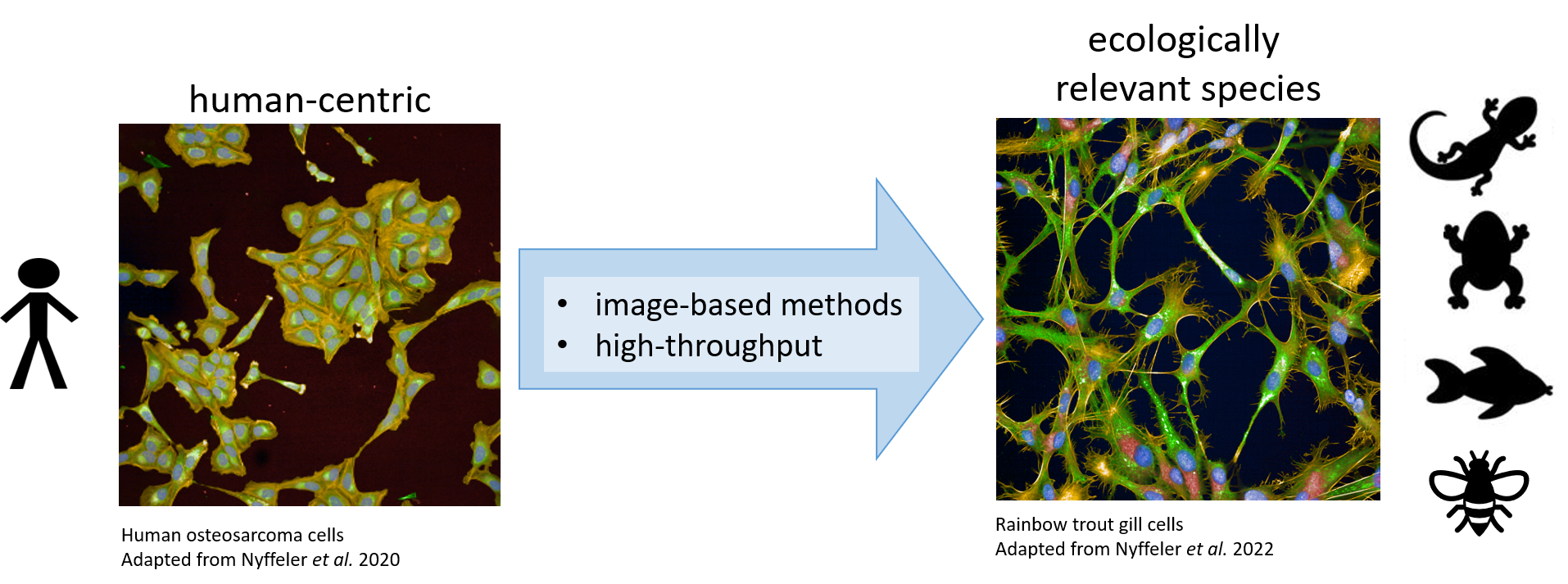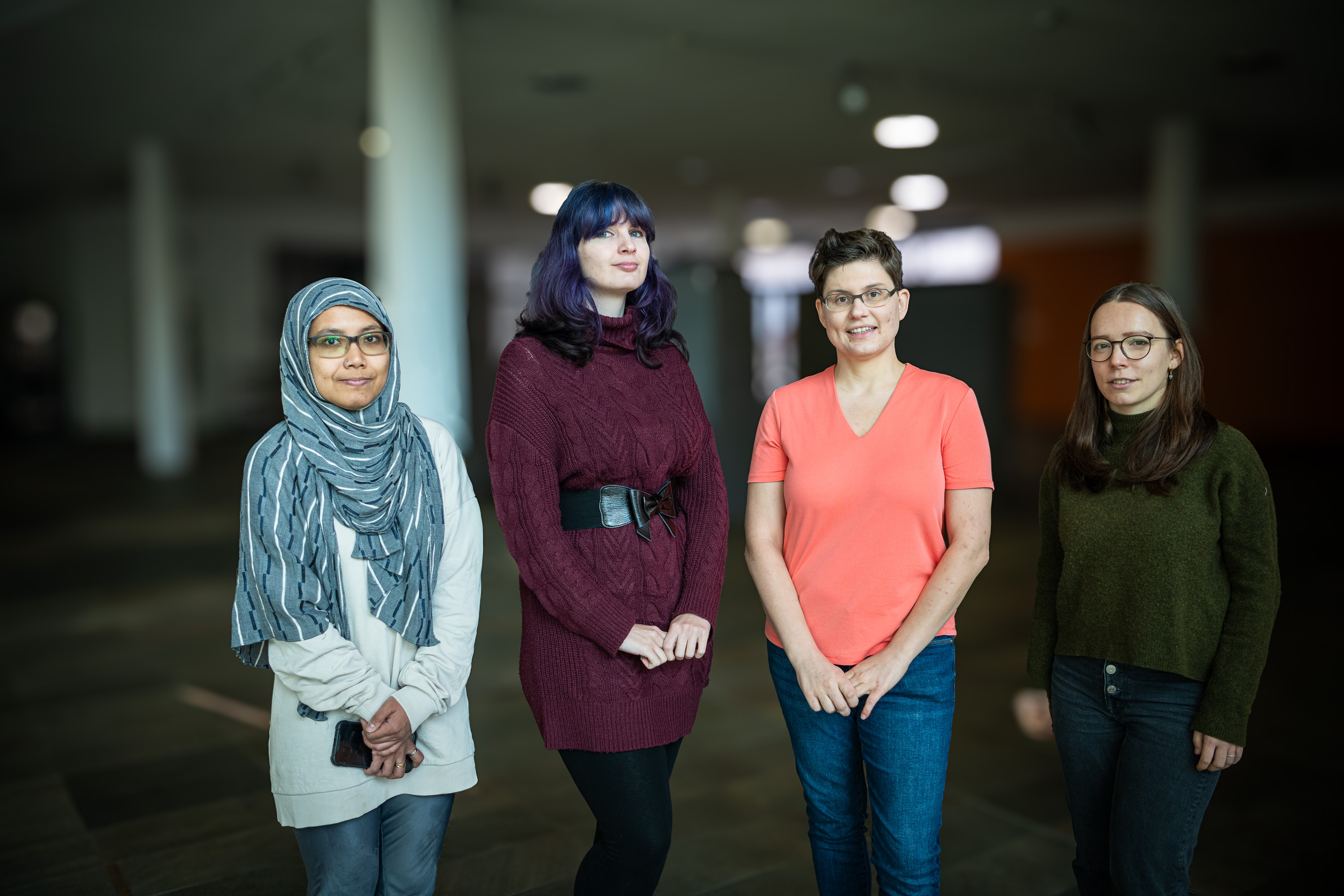New approach methods for high throughput ecotoxicology - HiTEC
The high-throughput ecotoxicology group aims to transform toxicity testing for non-human organisms. To complement the lower throughput organism assays run in our department, we develop novel, automated methods for testing chemicals and mixtures, which can be run at a higher throughput. For this, we leverage what has already been developed for human toxicology and translate it to environmentally relevant species. One assay of particular interest to us is ‘Cell Painting’ or high-throughput phenotypic profiling.

Current topics of our research group include:
Application of Cell Painting to environmentally relevant species
Cell Painting, though broadly applied to human cells is rarely used for non-human cells, such as fish or insect cells. We aim to apply Cell Painting to cell lines from vertebrate and invertebrate taxa. This allows us to:
- Screen chemicals at a higher throughput than many current test methods
- Test chemicals in taxa that would not be available for in vivo testing (e.g., reptiles, whales)
Application of Cell Painting to test environmental samples
We explore whether Cell Painting is applicable for testing environmental samples. If so, our high-throughput and high-content assay could provide useful, complementary information to existing assays.
Development of novel imaging-based assays for ecotoxicology
In addition to our high-throughput methods in vitro, we seek to develop medium-throughput imaging-based assays in whole organisms that can be multiplexed with existing assays.
Neurodegeneration Assay to test pesticides for the potential to induce Parkinson’s Disease
The PANDORA project is dedicated to testing pesticides in a neurodegeneration assay using human dopaminergic cells to identify chemicals that might induce Parkinson’s Disease in exposed workers.
Group members

Are you interested in joining us for a Bachelor or Master thesis? Contact us!
Dr. Jo Nyffeler
Group Leader
Phone: +49 341 6025 1264
E-Mail
Nicole Teßendorf
Technician
Phone: +49 341 6025 4064
E-Mail
Nisa Nurdhy
PhD student
Phone: +49 341 6025 2554
E-Mail
Luisa Reger
PhD student
Phone: +49 341 6025 2684
E-Mail
Publications
Index:
You could use our publication index for further requests.
2025 (3)
- Nyffeler, J. (2025):
Application of cell painting in environmental toxicology
Toxicol. Lett. 411 (Supplement), S32 10.1016/j.toxlet.2025.07.099 - Nyffeler, J., Harris, F.R., Willis, C., Byrd, G., Blackwell, B., Escher, B.I., Kasparek, A., Nichols, J., Haselman, J.T., Patlewicz, G., Villeneuve, D.L., Harrill, J.A. (2025):
A combination of high-throughput in vitro and in silico new approach methods for ecotoxicology hazard assessment for fish
Environ. Toxicol. Chem. 44 (9), 2599 - 2621 10.1093/etojnl/vgae083 - Piergiovanni, M., Mennecozzi, M., Barale-Thomas, E., Danovi, D., Dunst, S., Egan, D., Fassi, A., Hartley, M., Kainz, P., Koch, K., Le Dévédec, S.E., Mangas, I., Miranda, E., Nyffeler, J., Pesenti, E., Ricci, F., Schmied, C., Schreiner, A., Stokar-Regenscheit, N., Swedlow, J.R., Uhlmann, V., Wieland, F.C., Wilson, A., Whelan, M. (2025):
Bridging imaging-based in vitro methods from biomedical research to regulatory toxicology
Arch. Toxicol. 99 (4), 1271 - 1285 10.1007/s00204-024-03922-z
2024 (1)
- Escher, B.I., Blanco, J., Caixach, J., Cserbik, D., Farré, M.J., Flores, C., König, M., Lee, J., Nyffeler, J., Planas, C., Redondo-Hasselerharm, P.E., Rovira, J., Sanchís, J., Schuhmacher, M., Villanueva, C.M. (2024):
In vitro bioassays for monitoring drinking water quality of tap water, domestic filtration and bottled water
J. Expo. Sci. Environ. Epidemiol. 34 (1), 126 - 135 10.1038/s41370-023-00566-6
